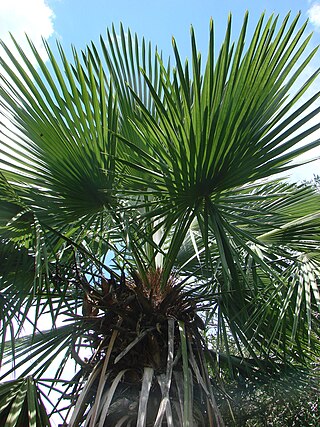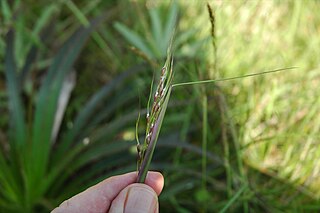Talian, or Brazilian Venetian, is a dialect of the Venetian language, spoken primarily in the Serra Gaúcha region in the northeast of the state of Rio Grande do Sul in Brazil. It is also spoken in other parts of Rio Grande do Sul, as well as in parts of Espirito Santo and of Santa Catarina.

Schoepfiaceae is a family of flowering plants recognized in the APG III system of 2009. The family was previously only recognized by few taxonomists; the plants in question usually being assigned to family Olacaceae and Santalaceae.
Hospital das Clínicas or Hospital de Clínicas is a denomination traditionally reserved for teaching hospitals in Brazil. Another common denomination is Hospital Universitário.

Aechmea cylindrata is a bromeliad, native to southeastern Brazil from São Paulo to Santa Catarina. This plant is cited in Flora Brasiliensis by Carl Friedrich Philipp von Martius, and it is often used as an ornamental plant.

Oxypetalum is a genus of flowering plants in the family Apocynaceae, first described with this name in 1810. The genus is native to South America.

Butia eriospatha is a small species of Butia palm endemic to the highlands of southern Brazil. It is very similar to B. odorata, but is easily distinguished from this species by the distinct spathes which are densely covered in rust-coloured, woolly hairs. Indeed, the specific epithet is derived from Greek ἔριον, wool, and Latin spatha, which refers to the spathe. It has been given the name woolly jelly palm (UK) or wooly jelly palm (US) in English. Vernacular names for it where it is native are butiá-da-serra, butiázeiro, butiá-veludo, butiábutiá verdadeiro, butiá-do-campo, yatáy and macumá.

Trithrinax brasiliensis is a species of flowering plant in the family Arecaceae. It is known as carandá, burití or leque. It is considered a rare and endemic species in southern Brazil. It occurs in Argentina, southern Brazil, and eastern Bolivia, where it is popularly known to Spanish speakers as saó or saocito and to speakers of Chiquitano as baixhíxh. Nowadays it is considered a threatened species belonging to the category "In Danger" in the List of Threatened species of Rio Grande do Sul state, southern Brazil.

Piptochaetium, or speargrass, is a genus of plants in the grass family, native to North and South America. Piptochaetium is a bunchgrass genus in the tribe Stipeae.
The Federal University of Fronteira Sul is a public, federally-funded Brazilian university serving the interior of Southern Brazil. It was formally founded by act of legislature in September 2009, and planned to graduate 10,000 students within its first five years.

Butia yatay, the jelly palm or yatay palm, is a Butia palm native to southern Brazil, Uruguay and northern Argentina. It is known as the butiá-jataí in Portuguese in the south of Brazil, as well as simply jataí or butiá. It is sometimes cultivated as an ornamental in Europe and the United States. It is the tallest of all the species in the genus Butia. The fruit is edible with a sweet flavour.
Picramnia parvifolia, the cedrinho, is a tree species that occurs in Brazil, in the regions Sudeste and Sul, and in Paraguay.
The Rio Bonito Formation is a geological formation of the Paraná and Pelotas Basins of Permian age. It is represented by a succession of cyclic sedimentary packages of sandstones, siltstones and shales which bear extensive deposits of coal that has been extracted since the 19th century. The Rio Bonito Formation was deposited in a coastal environment, formed by rivers, deltas, bays and estuaries with tidal plains, barrier islands and shallow marine platform, at a time when the Paraná Basin was a large gulf of the ancient supercontinent Gondwana. This gulf was open to the southwest, to the old ocean Panthalassa. The Rio Bonito Formation outcrops occur mainly in the eastern border of the Paraná Basin, in a narrow band in the states of São Paulo, Paraná, Santa Catarina, Rio Grande do Sul and Uruguay. The Rio Bonito Formation belongs to the second-order stratigraphic supersequence called Gondwana I.

Arjona is a genus of flowering plants in the family Schoepfiaceae. They are hemiparasites.

Arjona patagonica is a species of flowering plant in the family Schoepfiaceae native to southern South America.

Butia campicola is a very small species of Butia palm with an underground trunk; native to the cerrados of central Paraguay and south-central Brazil.
Butia microspadix is a very small species of grass-like Butia palm usually with an underground trunk; native to the states of Paraná and São Paulo in Brazil.
Butia arenicola is a very small species of Butia palm with an underground trunk; native to Paraguay and the state of Mato Grosso do Sul in Brazil. Boquierinho is recorded as a possible local vernacular name for it.
Butia matogrossensis is a smallish species of Butia palm with a trunk of only 0.5 m (20 in) in height or often subterranean, native to the cerrados of the centre, central-east, northeast and likely north of the state of Mato Grosso do Sul, after which it is named, in south-central Brazil. It also occurs in neighbouring south-central Goiás to the north. It is endemic to Brazil, occurring only in this country.
Peperomia velloziana is a species of perennial plant in the genus Peperomia. It primarily grows in wet tropical biomes.









